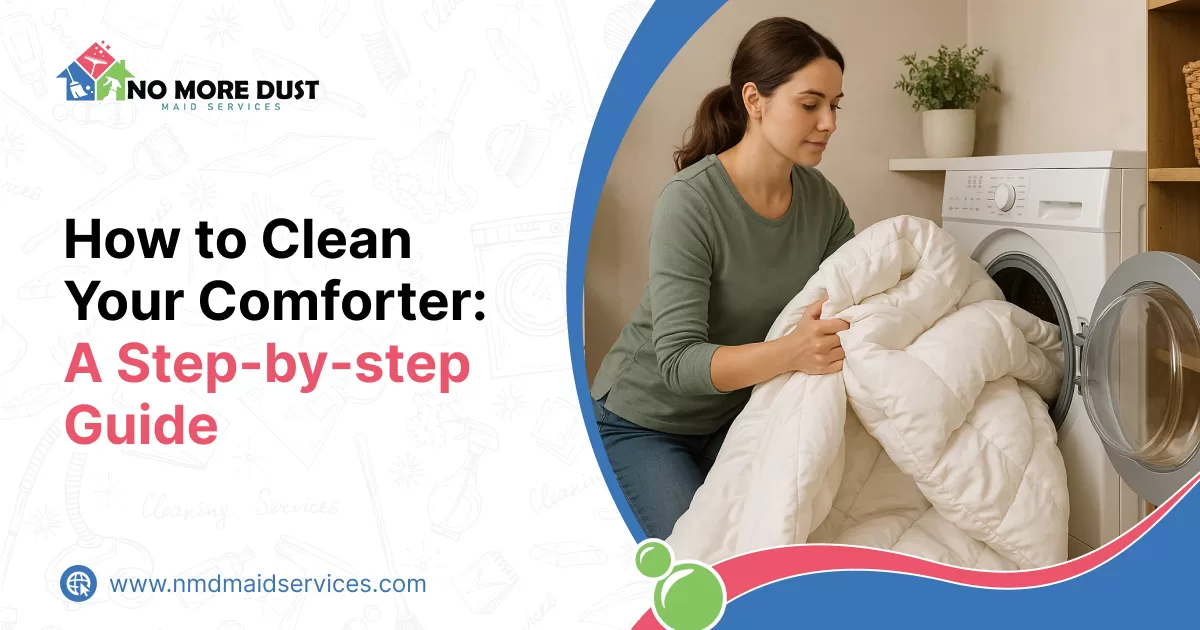How to Clean Your Comforter: A Step-by-step Guide

Before you wash your comforter, consider why washing regularly is necessary. Over time, allergens like dust mites, pet dander, and bacteria can build up, affecting your health and sleep.
A clean comforter doesn’t just look better—it makes a healthier space and can extend your comforter’s lifespan, keeping it cozy and functional for years.
Step #1. Preparing Your Comforter for the Washing Machine
Check the Label
Always start with a read of the care label. It will guide you on how to wash and dry your comforter safely. Down-filled ones are typically gentle, while synthetic ones are more forgiving.
Check for Stains and Damage
Inspect for any stains, rips, or heavy wear. Catching them early lets you pre-treat as needed, since heavy stains won’t always lift with a normal wash.
Pre-Treatment for Heavy Soils
Pre-treat stained spots with a mild detergent or water and soap mixture. Just lightly dab at the stain – don’t scrub – so the fabric isn’t ruined. Let it soak for 15 minutes first.
Step #2. Washing Machine—Your First Line of Defense
Selecting the Right Cycle
Comforters are big. They need room to breathe. A front loader or heavy-duty top loader is ideal. If not, send it to the laundromat, where the business washers will treat it for a deeper cleaning.
Setting the Right Cycle
Use a gentle or bulky cycle and cold or warm water according to the care label. Cold will stop shrinking; warm will loosen dirt. Choose a mild liquid detergent so that it doesn’t build up.
Balancing the Load
If your washer doesn’t like doing a bulky comforter, load towels to balance the drum. It washes more evenly and keeps the machine from wobbling.
Extra Rinse Cycle
Add an extra rinse if possible. It ensures all soap is washed out, which keeps the comforter soft and reduces the chances of skin irritation.
Step #3. Spot Cleaning
Some stains might stick around after a wash—this is where spot cleaning comes in.
What You’ll Need:
- Soft-bristled brush or old toothbrush
- White cloth
- Mild detergent or stain remover
- Warm water in a bowl
How to:
- Dab, Don’t Rub: Rubbing spreads stains or harms fabric.
- Test First: Test your solution on a hidden surface.
- Brush Gently: Loosen gently the dirt without damaging the surface.
- Pat Dry: Dry moisture off with a clean cloth and do it again if needed.
Special Considerations:
Down and feather fills need special care. Don’t soak them, and dry thoroughly each time. Synthetic fills are more tolerant but still deserve gentle handling.
Step 4: Drying Your Comforter
Air Drying vs. Machine Drying
Air drying in the gentlest, choose low heat, and add dryer or tennis balls to maintain the filling evenly spread.
Getting Fully Dry
Ensure your comforter is completely dry before storing. Moisture causes mildew or odors. Flat on a breezy room or outside on a sunny day, if air drying.
Maintaining Your Comforter
- Routine Airing: Shake and air weekly to avoid mustiness.
- Use a Duvet Cover: It protects the comforter and makes maintenance easy.
- Seasonal Washing: Wash every few months based on usage.
Need Help With the Dirty Work? We’ve Got You Covered
Need help getting your house to smell clean and healthy? Let us do it. We do the heavy cleaning for you so you can have peace of mind. Book with us today!

